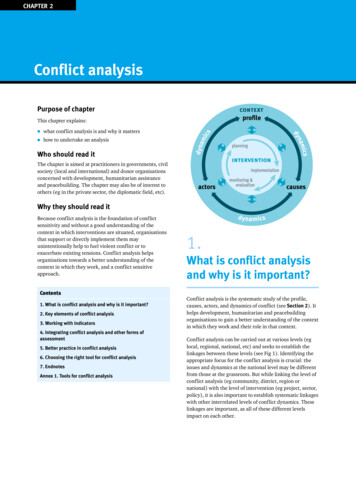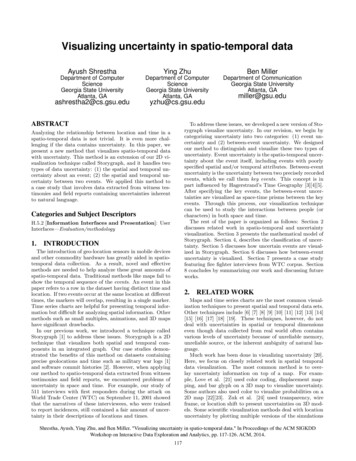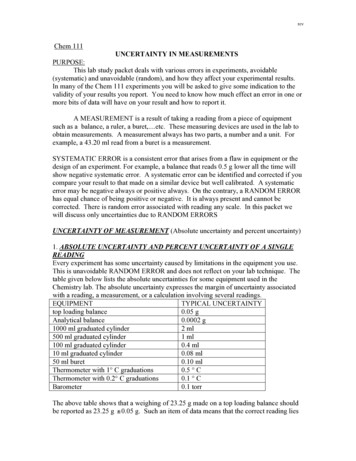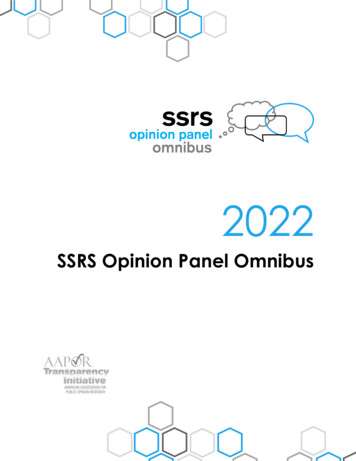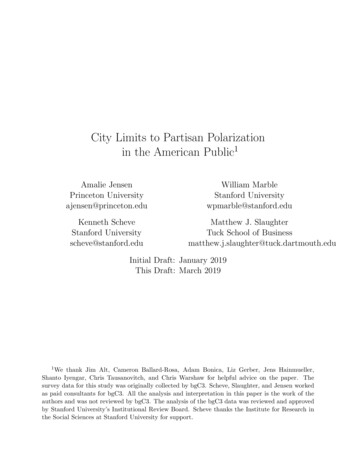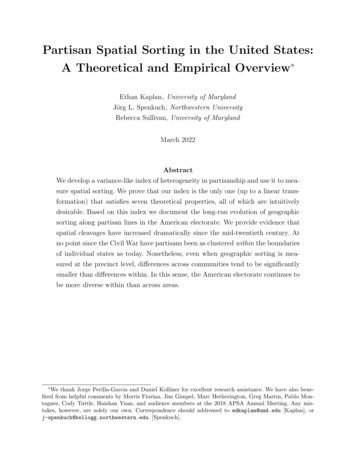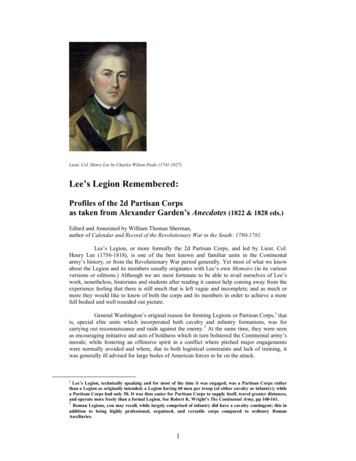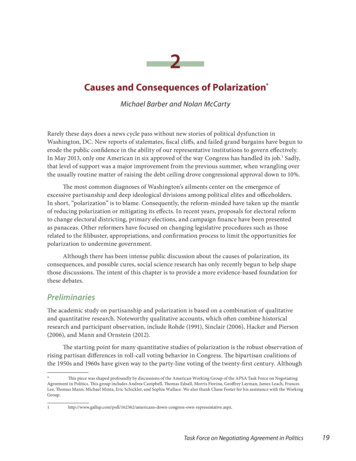
Transcription
econstorA Service ofzbwMake Your Publications iz Information Centrefor EconomicsFunke, Manuel; Schularick, Moritz; Trebesch, ChristophWorking PaperGoing to Extremes: Politics after Financial Crisis,1870-2014CESifo Working Paper, No. 5553Provided in Cooperation with:Ifo Institute – Leibniz Institute for Economic Research at the University of MunichSuggested Citation: Funke, Manuel; Schularick, Moritz; Trebesch, Christoph (2015) : Going toExtremes: Politics after Financial Crisis, 1870-2014, CESifo Working Paper, No. 5553, Centerfor Economic Studies and ifo Institute (CESifo), MunichThis Version is available ungsbedingungen:Terms of use:Die Dokumente auf EconStor dürfen zu eigenen wissenschaftlichenZwecken und zum Privatgebrauch gespeichert und kopiert werden.Documents in EconStor may be saved and copied for yourpersonal and scholarly purposes.Sie dürfen die Dokumente nicht für öffentliche oder kommerzielleZwecke vervielfältigen, öffentlich ausstellen, öffentlich zugänglichmachen, vertreiben oder anderweitig nutzen.You are not to copy documents for public or commercialpurposes, to exhibit the documents publicly, to make thempublicly available on the internet, or to distribute or otherwiseuse the documents in public.Sofern die Verfasser die Dokumente unter Open-Content-Lizenzen(insbesondere CC-Lizenzen) zur Verfügung gestellt haben sollten,gelten abweichend von diesen Nutzungsbedingungen die in der dortgenannten Lizenz gewährten Nutzungsrechte.www.econstor.euIf the documents have been made available under an OpenContent Licence (especially Creative Commons Licences), youmay exercise further usage rights as specified in the indicatedlicence.
Going to Extremes:Politics after Financial Crisis, 1870-2014Manuel FunkeMoritz SchularickChristoph TrebeschCESIFO WORKING PAPER NO. 5553CATEGORY 7: MONETARY POLICY AND INTERNATIONAL FINANCEOCTOBER 2015An electronic version of the paper may be downloaded from the SSRN website:www.SSRN.com from the RePEc website:www.RePEc.org from the CESifo website:www.CESifo-group.org/wpTISSN 2364-1428T
CESifo Working Paper No. 5553Going to Extremes:Politics after Financial Crisis, 1870-2014AbstractPartisan conflict and policy uncertainty are frequently invoked as factors contributing to slowpost-crisis recoveries. Recent events in Europe provide ample evidence that the politicalaftershocks of financial crises can be severe. In this paper we study the political fall-out fromsystemic financial crises over the past 140 years. We construct a new long-run dataset covering20 advanced economies and more than 800 general elections. Our key finding is that policyuncertainty rises strongly after financial crises as government majorities shrink and polarizationrises. After a crisis, voters seem to be particularly attracted to the political rhetoric of theextreme right, which often attributes blame to minorities or foreigners. On average, far-rightparties increase their vote share by 30% after a financial crisis. Importantly, we do not observesimilar political dynamics in normal recessions or after severe macroeconomic shocks that arenot financial in nature.JEL-Code: D720, G010, E440.Keywords: financial crises, economic voting, polarization, policy uncertainty.Manuel FunkeFree University of BerlinJohn F. Kennedy InstituteDepartment of EconomicsBerlin / Germanym.funke@fu-berlin.deMoritz SchularickUniversity of BonnDepartment of EconomicsBonn / Germanymoritz.schularick@uni-bonn.deChristoph TrebeschUniversity of MunichDepartment of EconomicsMunich / Germanychristoph.trebesch@econ.lmu.deOctober 11, 2015We thank John Ahlquist, Slantchev Branislav, Mark Copelovitch, Henrik Enderlein, Jeffrey Frieden, MarkHallerberg, Òscar Jordà, Alan Taylor, Stefanie Walter and participants at “The Political Economy of the EuroCrisis” workshops in Berlin and Zurich and the “Post-Crisis Slump” conference in Brussels. Lucie Stoppokprovided excellent research assistance. Schularick gratefully acknowledges financial support from the VolkswagenFoundation.
1IntroductionWith the catastrophe of the 1930s in mind, the fear of political radicalization in the wakeof economic and financial disasters looms large in public discourse. Recent events in theEurozone support such concerns. Since 2008, two-party systems that were stable for decadeswere swept away in the wake of the economic and financial turmoil. New political forceshave since entered parliament and gained ground, while others have disappeared from thepolitical map. In many countries, parties on the extreme right such as Front National inFrance or Golden Dawn in Greece have scored major electoral successes. Populist or openlyEurosceptic parties such as the Five Star Movement in Italy, Podemos, the party of TrueFinns, the UK Independence Party, or the Alternative for Germany have been surprisewinners in recent elections.Increasing fractionalization and polarization of parliaments makes crisis resolution moredifficult, reduces the chances of serious reform and leads to political conflict at a timewhen decisive political action may be needed most. A number of authors have linkedpolitical gridlock to slow recoveries from financial crises. Frieden (2015), Mian, Sufi, andTrebbi (2014) as well as Lo and Rogoff (2015) argued that dysfunctional politics contributeto the now well documented phenomenon of slow recoveries from financial crises (Jordà,Schularick, and Taylor 2013, 2014b).1 These ideas complement an important body of workin macroeconomics in recent years that has studied policy uncertainty and its economiceffects in more depth (Bloom, Bond, and Van Reenen 2007; Bloom 2009; Bloom et al. 2012;Bachmann, Elstner, and Sims 2013; Baker, Bloom, and Davis 2013). An important insightresulting from this literature is that measured policy uncertainty is particularly high afterfinancial crises. However, with few exceptions, there is limited empirical evidence on theunderlying channels.2What has history to say about the political after-effects of financial crises in moderndemocracies? Can we, over the long-run of modern history, identify systematic shifts in1Polarization and fractionalization may also have longer-term repercussions on the political economy. Forexample, Alesina and Tabellini (1990) and Azzimotti (2011) predict that more polarized political systemsproduce economic inefficiencies, higher debt, and lower growth. Alt and Lassen (2006), Lindqvist andÖstling (2010), Azzimonti and Talbert (2014) and Azzimonti (2015) provide empirical evidence supportingthis view.2An exception here are Baker et al. (2014) who show that political polarization was an important driverfor the increase in US policy uncertainty since the 1960s.1
voting behavior after financial crises? And if so, in which direction? Does the extreme leftor the extreme right gain, or both? To answer these questions, we examined the politicalaftermath of all major financial crises in advanced economies since the late 19th century.We also assembled the most ambitious and comprehensive historical dataset of electionresults and parliamentary composition to date, covering 20 countries and spanning 140years with more than 800 elections between 1870 and 2014.Our first key finding is that financial crises are followed by important changes in voterbehavior that in turn, contribute to high levels of policy uncertainty. Political polarizationincreases after financial crises throughout the 19th and 20th century. Moreover, politicalparties on the far right appear to be the biggest political beneficiaries of a financial crash.On average, far-right parties have seen an increase in their vote shares of about 30% relativeto their pre-crisis level in the five years following a systemic financial crisis. These findingsecho a recent study by de Bromhead, Eichengreen, and O’Rourke (2012), who focus onthe electoral consequences of crises in the 1920s and 1930s. We show that the gains offar-right parties were not limited to the interwar period: In recent decades, far-right parties,including populist parties of the so-called “New Right”, also saw broad-based electoralgains. After financial crises, voters seem to be systematically lured by the political rhetoricof the far right, with its frequently nationalistic or xenophobic tendencies. Moreover, weidentify an important asymmetry in the political response to crises: on average, the far leftdid not profit equally from episodes of financial instability.3Our second main insight is that governing becomes more difficult after financial crises,irrespective of which parties are in power. In particular, after World War II, crises areassociated with shrinking government majorities, a strengthening of opposition and greaterpolitical fractionalization. This in turn is associated with a higher probability of governmentcrises and changes in the executive branch. We thus confirm the finding of Mian, Sufi,and Trebbi (2014) that political fractionalization increases in the aftermath of financialcrises after 1980. However, using the depth of our historical dataset we can show thatthese effects have become stronger over time.Third, we document that street protests increase dramatically in the aftermath of finan3This finding somewhat contradicts Giuliano and Spilimbergo (2014) who link recession experiencesto distrust in institutions, leading to more right voting, as well as to more support of governmentintervention/redistribution, resulting in more left voting.2
cial crises. Riots, strikes and demonstrations can be seen as an additional proxy for politicalconstraints on governing. Passarelli and Tabellini (2013) have recently demonstrated howsocial unrest may negatively impact policy-making in democracies.These results are robust to controlling for macroeconomic and financial conditions aswell as political factors such as electoral systems, voter turnout, suffrage and differentgovernment systems.On the methodological side, we use the statistical toolkit of local projections (LPs)pioneered in Jordà (2005) and project the path of political variables over a five and tenyear horizon following the beginning of a financial crisis recession. As in Jordà, Schularick,and Taylor (2013; 2014a; 2014b), we compare the political aftermath of crisis recessions tothe aftermath of (non-financial) recessions. We find that the political effects of financialcrises are particularly more pronounced than those of normal recessions that tend to havelittle or no effects on political variables.A potential concern with these findings is that financial recessions could be deeperthan normal recessions and as a result the observed effects are due to the severity of therecession and not to the financial crisis. In the spirit of Barro and Ursúa (2008), we thencompare financial crisis recessions to other severe macroeconomic “disasters” that do notinvolve a financial crash. We find that the effects are much more pronounced in financialcrises and conclude that financial crashes stand out since their political after-effects areparticularly disruptive.On the data side, a core contribution of this paper is the compilation of a rich newdataset that will benefit future research in the field. Our newly compiled data covers thenear universe of systemic financial crises and general elections in 20 advanced economiessince 1870. Since financial crises are rare events, many researchers in this field have optedto go back in time and use longer time spans of data to study crises and their consequences(e.g., Reinhart and Rogoff 2009a, 2009b, 2015; Schularick and Taylor 2012; Perri andSteinberg 2012; Kose, Loungani, and Terrones 2013; Jordà, Schularick, and Taylor 2013,2014a; 2014b). We focus on advanced economies and intentionally avoid blending theexperience of developing and advanced economies. We study systemic banking crises onlyand avoid less precise definitions of financial crises that, to varying degrees, encapsulateinflation spurts, stock market crashes, currency crashes and sovereign defaults. For the3
coding of systemic banking crises, we rely on the papers by Jordà, Schularick, and Taylor(2013; 2014a).This paper is part of a growing literature on the political consequences of financial crises.The majority of existing studies focus on individual countries or shorter time windows.4An exception is Chwieroth and Walter (2013) who study leadership turnover during andafter banking crises in 20 developed and developing countries since 1830.5 Our analysisdiffers from these previous studies in that we focus on political responses to economiccrises in a broad sense, and not only on government survival or leadership turnover.6 Weare aware of only one paper with a similar focus, namely that of Mian, Sufi, and Trebbi(2014). Moreover, we are the first to study the link between crises and social unrest for abroad cross-country dataset, wich corroborates Ponticelli and Voth’s (2011) analysis of thepolitical effects of austerity policy.The structure of the paper is as follows. In the next section we introduce our dataset; inthe third section we discuss the statistical design. The fourth section contains the empiricalcore of our study: we demonstrate the electoral successes of far-right parties, the increasein political polarization and fragmentation, and its link to instability and uncertainty. Inthe fifth section we compare financial crises to severe and normal non-financial recessions aswell as to other macro disasters. The last section of this paper concludes and summarizesour findings.2DataIn this study, we draw on a broad set of historical data. This section describes the mainvariables used in our analysis, all measured at annual frequency and for the following 204See Eichengreen (1992); Haggard (2000); MacIntyre (2002); Bernhard and Leblang (2008); CrespoTenorio, Jensen, and Rosas (2012); de Bromhead, Eichengreen, and O’Rourke (2012).5They use the Reinhart and Rogoff (2009b) crises dating and follow the approach by Crespo-Tenorio,Jensen, and Rosas (2012) to measure political turnover risks. Their main result is that governments aremore likely to lose power following a financial crisis today, compared with during the 19th or early 20thcentury. Their interpretation is that citizens’ awareness of the ability of the government to manage theeconomy increased dramatically in the wake of the Great Depression and World War II. Another recentlong-run analysis is by Ahlquist, Anselly, and Lindvall (2014), who find that the political cost of exiting afixed exchange rate regime is high, both before and after World War II.6Specifically, we consider the vote share of government coalitions regardless of whether they were thegovernment that led the country into the crisis or were the one that replaced it. We are not mainly interestedin the (somewhat unsurprising) punishment of poor economic policy-making and crisis management byincumbent governments, but in the general ability of a country to establish political stability and leadershipin the aftermath of a financial crisis.4
developed economies: Australia, Austria, Belgium, Canada, Denmark, Finland, France,Germany, Greece, Ireland, Italy, Japan, the Netherlands, Norway, Portugal, Spain, Sweden,Switzerland, the United Kingdom and the United States. Appendix Table A1 lists thedefinitions and sources for our main variables, and Appendix Table A2 shows the summarystatistics.2.1Election results and parliamentary composition, 1870-2014We compiled an archive of 827 parliamentary elections from throughout history. This newdataset, encompassing the years from 1870-2014, includes detailed information on generalelections to the national parliaments of the 20 countries in our sample. Presidential elections,non-nationwide (regional or local) elections and referendums are excluded. In case of twoor more elections in one year (e.g., Greece in 2012), we count the last election in that year.In the case of bicameral legislatives (e.g., in the United States), only elections to the lowerchamber are considered (e.g., the US House of Representatives). Altogether, we identified859 elections, but could not find sufficient data for 32 of these. Therefore, the final sampleincludes 827 election events.7 Appendix Table B1 gives an overview of which parliamentaryelections we coded and shows the names of the respective parliaments/chambers as wellas cases with missing data. The information on vote shares and on the distribution ofseats in parliament come from three main sources, namely Döring and Manow (2012),Mackie and Rose (1974) and Nohlen and Stöver (2010). In addition, we drew on a series ofcountry-specific sources, which are also listed in Appendix B.Based on the raw data, we group the vote shares along several dimensions. First, weadd together votes of anti-system parties, i.e., vote shares of parties on the far left orthe far right, which seek to change the system of government per se (see Sartori 1976). Tocategorize parties as far-right or far-left we follow de Bromhead, Eichengreen, and O’Rourke(2012) for the interwar period (1919-1938). Extremist parties in the pre-1919 period areignored, simply because there are no sufficient sources for a clean classification. For the7Another reason for missing data were institutional factors. In the 19th century, some parliamentsconsisted merely of unlinked, nonpartisan candidates from various constituencies. It was therefore notpossible to assign members to parties and to compute vote and seat shares. This was the case in the Dutchgeneral elections from 1871-1887 (Mackie and Rose 1974, p. 267), the Norwegian parliamentary elections1870-1879 (Rokkan 1967, p. 376) and the Swedish general elections from 1872-1884 (Stjernquist 1966, p.120).5
period after 1939, we track the parties coded as extremist by De Bromhead, Eichengreen,and O’Rourke (2012), and their follow-up or splinter formations. Furthermore, we identifynewly formed parties on the extreme left and right by assessing the political platformof each party gaining more than 0.1% of the vote in our post-World War II sample ofelections. For this purpose we draw on Betz (1994), Ignazi (2003), Minkenberg (1998; 2001;2008), Minkenberg and Perrineau (2007), Mudde (2000; 2005; 2007), country reports byBertelsmann Stiftung (2009), as well as large number of country-specific sources listed inAppendix B.In the spectrum of far-right parties, we include parties of the “New Right”, i.e., thoseparties in the grey area between far-right extremism and right-wing populism. This followsthe widespread view in political science literature that the profile of the political far righthas undergone fundamental changes since World War II (e.g., Betz 1994; Ignazi 2003).Many parties discarded openly fascist and anti-democratic attitudes and adopted a moremoderate tone in reference to ethnocentrism, nationalism and secessionism, most recentlyoften combined with a Eurosceptic platform. On the far left, we include all parties thattake up traditional communist and/or Marxist-Leninist positions. Similar to the right wingviews, we also include parties that would not be identified as communists in the traditionalsense, but included those who refuse contemporary international economic order and basetheir national economic policies an anti-capitalist ideology (e.g., “The Left” in Germany).Some of these parties can also be classified in the populist, Eurosceptic spectrum. Forexample, we code the “United Left” in Spain and the Italian anti-establishment party “FiveStar Movement” as far-left parties. Appendix Table B2 provides further details and showsall parties classified as far-right and far-left in our sample.Second, we add up the government vote share by combining the votes of thegoverning party or of parties in the governing coalition, as well as the opposition voteshare, which is done by combining the vote share of all parties in the opposition. This waspossible to do for most countries since 1870, although we exclude elections in monarchies inthe early years of the sample, i.e., of the German Reich, Denmark, Finland (under Russianoccupation), Japan, Norway, Portugal, Spain and Sweden. We also exclude elections in thefascist and military dictatorships of Germany (1933-1945), Italy (1924-1945), and Portugal6
(1926-1974).8 The distinction between government and opposition does not make muchsense for these countries during those time periods. We again refer to Appendix Table B1,which gives a condensed overview of the elections in our sample and their characteristics.To identify government and opposition we draw on a wide range of sources, in particularDöring und Manow (2012), as well as a series of country-specific sources listed in AppendixB. In parliamentary systems, we code those parties that were represented in the cabinetas government parties. In presidential systems, we code only the president’s party as thegovernment party, while all remaining parties are coded as opposition parties. We excludeindependent candidates without party affiliation, since they may switch sides depending onthe law that is under consideration (this follows Mian, Sufi, and Trebbi 2014). If there is achange in power in a given year, we code the vote shares of the newly elected government,not of the outgoing one.9Lastly, we code two measures on the degree of parliamentary fragmentation based onthe raw data on seats in parliament.10 First, we simply count the number of parties inparliament. Second, we consider the distribution of parliamentary seats among partiesfollowing the more sophisticated approach implemented by Beck et al. (2001). Specifically,we code a long-run measure of fractionalization, which is defined as the probability thattwo representatives picked at random from among the parties in the legislature will be ofdifferent parties. More formally this can be written as:legislativef ractionalization 1 nX(ni 1) nNi[i 1N 1] ,where n number of parties, ni seats held by the n-th party, and N total seats inthe parliament. Of course, in this context of course the definition of “party” is crucial.See Appendix B for details on the coding of this variable. The fractionalization measureis bound between 0 and 1. The lowest value of 0 indicates no fractionalization, while thevalue of 1 indicates maximal fractionalization.8There were no elections in Spain from 1936-1974 and in Greece from 1937-1941 and from 1967-1973.Whenever government formation after an election exceeds the turn of a calender year (e.g., in theUnited States) we record the year in which the election took place. In cases of interim governments wedenote the next partisan government that took office.10To go as far back as possible, these measures are computed for all elections, except for the electionsheld during the dictatorships in Germany from 1933-1945, in Italy from 1924-1945, and in Portugal from1926-1974. In other words, we explicitly include monarchies with a legislature. However, the results arealso robust to when monarchies are excluded.97
2.2Street protests, 1919-2012In addition to the parliamentary variables, street protests are good indicators of politicalradicalization and serve as a proxy for political instability in the post-crisis period (see, forexample, Ponticelli and Voth 2011; Passarelli and Tabellini 2013). To approximate streetprotest we rely on the dataset of Banks and Wilson (2014), which provides information onthe annual frequency of domestic conflict events from 1919 to 2012 (excluding the World WarII period from 1940 to 1945). In particular, we consider the number of general strikes,defined as “any strike of 1,000 or more industrial or service workers that involves more thanone employer and that is aimed at national government policies”, the number of violentriots, defined as “any violent demonstration or clash of more than 100 citizens involving theuse of physical force”, and the number of anti-government demonstrations, defined as“any peaceful public gathering of at least 100 people for the primary purpose of displayingor voicing their opposition to government policies”. We use the sum of these three variablesas our baseline variable – termed street protests – to measure the overall degree of openprotest in the street.In comparison to our other dependent variables, street protests show strong time trends,which is evident when looking at Figure C1 in the appendix. The degree of social unrestis very volatile and can double from one decade to another; our data shows peaks duringthe 1960s and 2010s. At the same time, there is on average long periods with little streetprotest, e.g. the 1980s and 1990s. To deal with time trends in the data, we decomposed thevariable into a trend and cycle component. Specifically, we apply the widely used HodrickPrescott filter (see Hodrick and Prescott 1997) with a smoothing parameter of 6.25. Usingit as dependent variable, we then compute the percent deviation from trend for the streetprotest variable. This reduces the risk of spurious inference, but also makes the resultssomewhat harder to interpret.2.3Financial crises and recessionsFinancial crises are defined as events during which a country’s banking sector experiencesbank runs, sharp increases in default rates accompanied by large losses of capital that8
result in public intervention, bankruptcy, or forced merger of financial institutions.11 Datesof systemic financial crises are based on the study by Jordà, Schularick, and Taylor (2013),which build on the timing of historical crisis events pioneered by Bordo et al. (2001) andReinhart and Rogoff (2009b). The Laeven and Valencia (2008, 2012) dataset of systemicbanking crises is the main source for post-1970 crisis events. Appendix Table D1 shows afull list of the 103 financial crises in our dataset.Besides financial crisis dates, we also determine the dates of recessions following thedata and methodology in Jordà, Schularick, and Taylor (2013). Specifically, we generatetwo auxiliary dummy variables using the intuition in the Bry and Boschan (1971) algorithmto capture business cycle features in the data. This algorithm separately generates datesof peaks and troughs in economic activity for each country in our sample. Using real GDPper capita, a peak corresponds to a local maximum and a trough corresponds to a localminimum. A recession is defined as the period between a peak and the following trough,whereas an expansion is defined as the period between the trough and the subsequent peak.For the empirical analysis, we then make the distinction between recessions thatcoincide with a major financial crisis – termed financial crisis recessions – and thosewithout major financial disruptions – termed normal recessions. More precisely, we calla recession financial if a major financial crisis erupts within a two year window aroundthe peak of the cycle. Appendix Table D2 shows the full list of financial and normalrecessions in our dataset. Benchmarking normal vs. financial recessions allows for cleaneridentification of the effects of financial crises rather than comparing financial crises spellsto a counterfactual of all other years. However, normal recessions are typically less severethan financial recessions. Therefore, as a second benchmarking exercise, we also comparefinancial recessions to a subset of normal recessions that are particularly deep. In the spiritof Barro (2006) and Barro and Ursúa (2008; 2011), we term these severe normal recessions asnon-financial macro disasters. Specifically, we keep only those non-financial recessionswith an average GDP p.c. decline that is higher than the average GDP decline duringfinancial recessions. We apply this cut-off separately for the pre-World II sample (with athreshold of -3.35%) and for the post-World War II sample (with a threshold of -2.55%).11Jordà, Schularick, and Taylor (2014a) emphasize the distinction between isolated banking failures (suchas the demise of Baring Brothers in the U.K. in 1995) and systemic distress (such as the Global FinancialCrisis 2008). However, their systemic financial crisis classification has proven valuable in previous studies.9
The end result is a list of non-financial macro disasters provided in Appendix Table D3.On average, these events see a GDP contraction of 5.82% per year. The results are similarif we use a full-sample average, or if we use the median GDP contraction as a cut-off.Similarly, the results are roughly the same if we apply an even stricter threshold and onlyconsider the worst 25% normal recessions (those with the highest GDP contractions).3Statistical designFor each dependent variable, we start with a preliminary view of the data, includingsummary statistics, visual plots of the data and OLS panel regressions. We then takethe time dimension more seriously and estimate local projections (LPs) following themethod pioneered by Jordà (2005) and applied in a range of closely related studies (Jordà,Schularick and Taylor 2011; 2013; 2014a). Moreover, we provide a range of robustnesschecks of our estimates.In a first step, we compare pre-crisis spells with post-crisis spells following Mian, Sufi,and Trebbi (2014). Specifically, we restrict the sample to a full five years before and afull five years after a financial crisis, excluding the crisis year itself. In cases of follow-upcrises, where the five year pre-crisis horizon and the five year post-crisis horizon overlap,we exclude subsequent crises as we interpret them as after-effects of the initial crisis. Notethat crises where either the crisis event itself or one of the five year windows coincides withyears of global wartime (1914-1918 and 1939-1949) are omitted from the sample. We againrefer to Appendix Table D1, which also indicates the 67 (of 103) crises that are consideredin the descriptive analysis.In step two, we then expand the analysis to more broadly compare crisis t
Partisan conflict and policy uncertainty are frequently invoked as factors contributing to slow post-crisis recoveries. Recent e
